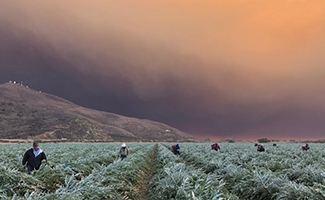Occupational Health Watch: September 2021
Protecting Workers from Wildfire Smoke
In 2020, California had five of the largest wildfires in state history during that one year alone. This year, the Dixie fire continues to burn and is now the largest single wildfire in state history. Poor air quality due to wildfire smoke may persist for months and spread to neighboring counties and states. Smoke is made up of a mixture of gases and fine particles that can cause a range of health problems. These respiratory irritants can cause coughing, wheezing, and difficulty breathing; they can also cause aggravation of pre-existing medical conditions and increased risk of premature death.

Outdoor workers such as agricultural workers, landscapers, and construction workers are especially affected by wildfire smoke exposure. Cal/OSHA's Protection from Wildfire Smoke Regulation requires employers to take important measures to protect their employees when the Air Quality Index (AQI) of harmful particulate matter (defined as "PM2.5" because of particle size) at their worksites is 151 or greater. As fires become a growing problem, workers need to be protected from smoke and poor air quality. (Photo credit: Stephanie Rodriguez, courtesy of Central Coast Alliance United for a Sustainable Economy)
What does the regulation require employers to do?
Identify harmful exposures – Determine employee exposure to wildfire smoke at the start of each shift and periodically thereafter by obtaining AQI forecasts (available online).
Communication and training – Train workers and supervisors on the health effects of wildfire smoke, the right to obtain medical treatment without fear of reprisal, methods to protect employees from wildfire smoke, and the use and limitations of respirators.
Reduce workers' exposure to wildfire smoke using:
Engineering controls: Where possible, provide an enclosed building, structure, or vehicle with filtered air for employees to spend some or all their time.
Administrative controls: Relocate workers to another outdoor location where the current AQI is lower, change work schedules, reduce work intensity, or provide more rest periods (preferably in cleaner air).
Personal protective equipment:
- Provide NIOSH-approved particulate respirators (such as N95 masks) to employees for voluntary use if employers cannot reduce workers' exposure using the methods above.
NOTE: When the AQI of PM2.5 is greater than 500, employers must provide and require employees to use N95 masks.
Provide eye protection where employees are experiencing burning sensations, redness, and tearing of the eyes caused by wildfire smoke.